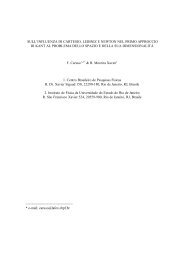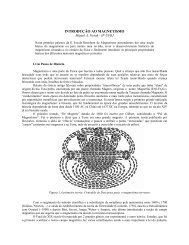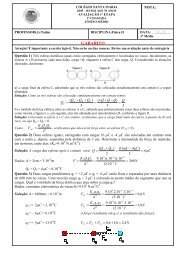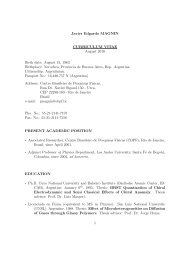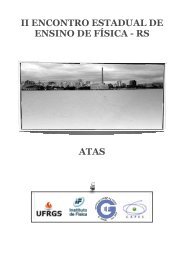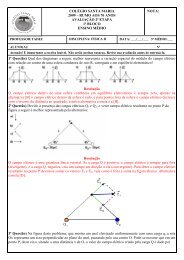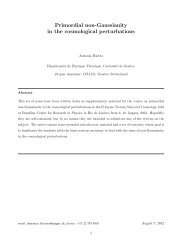SOURCES FOR THE HISTORY OF SPACE CONCEPTS IN ... - CBPF
SOURCES FOR THE HISTORY OF SPACE CONCEPTS IN ... - CBPF
SOURCES FOR THE HISTORY OF SPACE CONCEPTS IN ... - CBPF
You also want an ePaper? Increase the reach of your titles
YUMPU automatically turns print PDFs into web optimized ePapers that Google loves.
2 <strong>CBPF</strong>-NF-084/96<br />
that even making this sharp restriction on the subject we did not overcome the dificulty mentioned<br />
in the first paragraph: a bibliography aimed at providing a sound basis for the study of this problem<br />
should, indeed, also cover many other aspects of the Natural Philosophy of Space. On the other hand,<br />
from the recurrence of certain quotations, we also realized that there were many relevant references<br />
that could not be omitted owing to our difficulty in localizing them. In addition we have done an<br />
effort to include some very rare references. Therefore, our original plan followed a completely new<br />
direction; these are in a nutshell the main reasons for the significant time gap between thinking out<br />
the bibliography and rendering it available now. Let us in the sequel say some words about our choices<br />
in preparing this bibliography.<br />
The most restrictive choice was to constrain the bibliography in time. The period covered here<br />
is of circa a hundred and fifty years; more precisely, the bibliography includes references from 1845 to<br />
1995. The former is approximately a century after the publication of Kant’s first work — Gedanken von<br />
der wahren Schätzung der lebendigen Kräfte, Königsberg, 1747, (English translation by J. Handyside,<br />
Kant’s inaugural dissertation and the earlywritings on space, Chicago, Open Court, 1929) —, which<br />
can be considered a milestone in so far as the problem of space dimensionality is concerned. For<br />
treating this problem Kant had to consider the possibility of the existence of spaces with a different<br />
number of dimensions, prior to any formal theory for these types of space. In his own words: “A<br />
science of all [the] possible kinds of space would undoubtedlybe the highest enterprise which a finite<br />
understanding could undertake in the field of geometry”. It was during the nineteenth century that<br />
this quote acquired its full sense and very remarkable generalizations in Geometry were done, leading<br />
to the conclusion that the space defined by Euclid’s axioms is not the only possible non-contradictory<br />
construction. Non–Euclidean geometry and n–dimensional space not just contributed to change the<br />
Weltanschauung at that time, but also had a very impressive impact on the development of Physics<br />
in the twentieth century, from Relativity and Quantum Mechanics to Unified Field Theories.<br />
One of the main consequences of such choice is that actually a very large number of well known<br />
primary sources of the western philosophy for the study of space — as the original contributions of<br />
the Pre–Socratics, Plato, Aristotle, Simplicius, Galileo, Newton, Leibniz, Kant, and many others —<br />
are not included in the present bibliography. Thus, for not introducing an asymmetry in the period<br />
covered here we decided to limit ourselves to quote what can be called secondary sources on the<br />
concept of space in Physics, which include: books, the majority of which are entirely dedicated to<br />
historical and/or philosopical aspects of this subject (presented as item a.); specialized articles and<br />
contributions to proceedings (item b.); chapters of books, dissertations, articles in encyclopaediae,<br />
entries of dictionaries, abstracts and other miscellaneous citations (item c.). It should be stressed<br />
that textbooks and technical Physics papers are excluded from the present bibliography.<br />
Another important restriction is imposed by language: only texts written in English, French,<br />
German, Italian, Spanish, Portuguese and Latin were considered.<br />
Two other simple but nevertheless restrictive criteria were followed and should be mentioned. Although<br />
we recognize the impact of the Theory of Relativity on modern Physics epistemology, neither<br />
papers devoted exclusively to time nor technical papers on spacetime are brought into the bibliography,<br />
which, of course, excludes any reference to the fundamental (and well known) papers of the<br />
scientist–philosopher A. Einstein. We are convinced that Relativity, by itself, deserves an independent<br />
bibliography. However, some basic references on the philosophy of spacetime were occasionally<br />
included. Both choices were mainly motivated by our will to render the bibliography manageable.<br />
It should also be stressed that special attention was given to the modern literature concerning the<br />
veryold problem of space dimensionality, biased by our interest on this subject. Only in this case<br />
the authors made a particular effort to be complete, even knowing apriorithat this is an impossible<br />
task. Clearly, due to the interrelations of Physics with the aforementioned areas, we could not resist<br />
the temptation of including a small number of references on infinity, aether, foundations of geometry,<br />
and some references belonging to the domain of other areas, although, in this case, completeness was<br />
absolutely not our goal: our intention was just to offer to the reader the possibility of starting by<br />
himself the search for new references on those areas.




